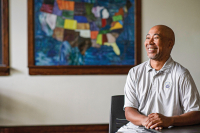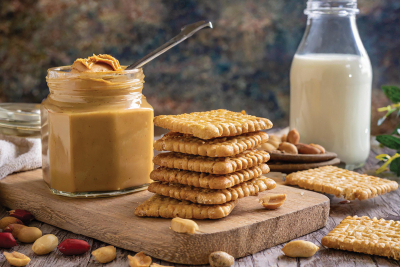Reimagine Bartram’s travels
A visual exploration of the Blue Ridge Bartram Trail will be on display through Jan. 6, 2024, at The Bascom in Highlands.
The Bascom puts a twist on art, craft exhibits
Hearing The Bascom being called a world-class facility might seem a stretch until you pay a firsthand visit to the six building, six-acre campus in Highlands. Then, however, the words seem entirely appropriate and scaled to reality.
The Bascom is a center for the visual arts created in 2009. The nonprofit doesn’t have a large private collection of works; the center instead focuses on providing top-notch exhibitions primarily garnered from across the Southeast. Six exhibitions were held last year. These included shows featuring glass artist Richard Ritter, painter and printmaker Frank Stella and ceramics maker Ben Owen.
The advantage to artists showing in this well-heeled, upscale Highlands market is huge: The Owen’s show, featuring the Seagrove potter’s signature pieces, almost completely sold out, The Bascom’s Ezra Gardiner said.
That kind of track record helps The Bascom lure a caliber of artists few other similar-sized facilities can boast of attracting.
Some of the highlights this year include an exhibition of paintings by Art Rosenbaum and the large-scale, kinetic sculpture of suspended ceramic discs that are mounted and hung from the ceiling by artist Tim Curtis. There also will be an exhibit titled “Her Impressions” featuring paintings by women during the Impressionism movement using works on loan from a number of Southeast museums and institutions.
There’s one important point about The Bascom that people working at the center are eager to make. The center takes great pride in putting what Executive Director Jane Jerry calls “The Bascom twist” on exhibits while they are displayed here.
“You can only do that with a small institution like this,” said Jerry, who has led The Bascom for about a year.
What does “The Bascom twist” entail? For his part, Gardiner described the twist as “putting a spin on it” by showing artists’ pieces in a manner that is unique and design rich — from the manner in which the pieces are placed and lighted for viewing to drawing on the attributes of the facility itself. Most of the shows are curated in-house by staff, and during the summertime are displayed for eight-week periods at a time. Big exhibitions are in the main gallery, smaller ones in a loft gallery upstairs from the primary viewing area.
Much of “The Bascom twist” is truly the setting of the facility itself: you enter the center through an 87-foot by 14-foot, 53-ton covered bridge transplanted to WNC from New Hampshire.
Once on campus, the main building is 27,500 square feet of museum-quality space made of hand-hewn, post-and-beam barn pieces accentuated with modern stone and glass. Even the floors are unstained white pine re-purposed from several historic barns. There also is a studio barn, a rebuilt rough-hewn barn complete with studio spaces for pottery and three-dimensional arts instruction.
So much of “the twist” is the fact that the paintings, ceramics, metal work and glass pieces are shown in a backdrop that is truly unique.
Understanding the community
Setting up and running The Bascom probably wouldn’t be possible in WNC outside of a venue such as Highlands, where the residents are affluent and visibly supportive of the arts. In addition to The Bascom, this is a community that can boast of the Highlands Playhouse, the Highlands Cashiers Chamber Music concerts, the American Museum of Cut and Engraved Glass and the Instant Theater Company, featuring improvisation.
“Highlands and the whole plateau area is different from other communities,” Jerry said. “I’m so new, it has taken me a while to understand the profile of donors and funding sources here.”
The Bascom, in becoming The Bascom, has successfully tapped more than 800 sources — corporations and foundations but mainly individual — in paying about $9 million of the $13 million in its construction campaign. Fundraising continues for this new facility, and for a separate educational and exhibitions program endowment.
Jerry said The Bascom, in comparison to most galleries and art centers featuring the caliber of artist being exhibited here, is so small “we just haven’t had a lot of government support — mainly individual.”
The Bascom has a mortgage on the property that the nonprofit is in process of paying off. And with a board of directors totally committed to offering free admission to the arts, fundraising is key to the facility’s current and future wellbeing.
“I don’t want to sugarcoat the idea that this isn’t an ongoing challenge. We are raising money all of the time,” said Jerry, adding that fundraising “is the job” for any manager of a nonprofit.
Jerry was most recently the project-planning director for Exploration Station, the Republic of Ireland’s first interactive science center. Prior to her stint in Ireland, Jerry was the president and CEO of Cheekwood Botanical Garden and Museum of Art in Nashville, Tenn. She’s no stranger to fundraising challenges: During her tenure at Cheekwood, Jerry led a capital campaign that resulted in an $18.5 million investment in the garden and facilities, and the Cheekwood Museum of Art attained accreditation by the American Association of Museums.
The Bascom has three main benefit events: a wine festival in May; a garden festival in July; and an art, design and craft show in October. It also has an extensive membership of 946 people, plus 300 or so volunteers who provide a veritable army of help to the 10 paid staff members.
Jerry said that she has spent this first year trying to be “a really good listener, and to understand The Bascom and its place in this community. And to work as hard as I can to begin to define a vision for the future that is a reflection of what this community wants.”
One thing the community clearly wants is a tangible connection with The Bascom. Outreach programs make that connection, plus appeal to donors, Jerry said. Among the upcoming programs this spring is a partnership with the Highlands Literacy Council’s after-school art program. This focuses on sea life and will result in an “Underwater” exhibit being installed in the fall.
The Bascom also partners with the local food pantry and with other groups as part of its outreach programs, plus provides scholarship money and free family memberships to the facility.
The Bascom history
The Bascom exists because of artist Watson Barratt, a part-time Highlands resident who died in 1962, who wanted to establish a permanent gallery in his seasonal home to display works by regional artists. His bequest made exhibition space at the Hudson Library in Highlands possible starting in 1983. The then Hudson Library building incorporated proceeds from the estate and included a dedicated space for the Bascom-Louise Gallery.
In 1999 the two entities separated. The art center attained nonprofit status, formed a board of directors, wrote bylaws and hired staff. In 2009, The Bascom moved to its new campus.
Source: The Bascom
At The Bascom
• “Chick’s: It’s All Gone to the Birds,” March 31-June 17.
• Alex Matisse: “Ometto,” May 12-Oct. 1.
• “Green Art:” May 17-July 8.
• “Her Impressions:” June 23-Sept. 16.
• “Bascom Members Challenge, Couples:” Aug. 18-Oct. 14.
• Art Rosenbaum: “Voices,” Sept. 1-Nov. 10.
• American Craft Today: Sept. 22-Dec. 29.
• “Giving Trees:” Nov. 17-Jan. 1.
www.thebascom.org for additional details. Admission is free.
Woodturning magic returns to The Bascom
A new exhibition of lathe-made bowls from acclaimed artists Philip and Matt Moulthrop will be on display in the Bascom’s Atrium Gallery through Nov. 6.
The Highlands-Cashiers plateau boasts a strong concentration of private Moulthrop collectors, in part because of the Wade Hamptom Golf Club annual golf tournament that once yielded a prize of a Moulthrop-turned bowl. All works in this exhibition are for sale and the customer can take the work home when purchased.
Exhibitions at The Bascom are free and open to the public from 10 a.m. to 5 p.m Tuesdays through Saturdays. It will also open from noon to 5 p.m. on Sundays through Oct.1.
www.thebascom.org or 828.526.4949.
Bold art featured in ‘Fire and Heat by Three’
Gunpowder, furnaces and kilns are used by three featured artists in the “Fire and Heat by Three” exhibit, which opens on Saturday, Sept. 11, at the Bascom in Highlands. Experience traditional and innovative uses of materials glass artist Alex Bernstein, mixed media artist Mira Lehr and ceramist Tom Turner.
All three are known for their bold, unique perspectives. Lehr has been described as a visual poet. She uses nature-based images to explore the possibilities of painterly experiments. Turner, whose work focuses on classic, ageless beauty, is known for beautiful thrown forms with complex and difficult glazes. Bernstein explores visual form and storytelling with the impact and optical quality of glass. The exhibition is a fusion of their creative visions explored through multiple media.
Other exhibitions now at The Bascom: Kick-start! American Motorcycle Design; Small Works Challenge, Bascom Members; Selected Works from the Bascom Collection, Patrick Dougherty’s Do Tell environmental sculpture; and On View: Artists in Residence and Three Weavers.
828.526.4949, ext. 100 or www.thebascom.org.
Bold art featured in ‘Fire and Heat by Three’
Gunpowder, furnaces and kilns are used by three featured artists in the “Fire and Heat by Three” exhibit, which opens on Saturday, Sept. 11, at the Bascom in Highlands. Experience traditional and innovative uses of materials glass artist Alex Bernstein, mixed media artist Mira Lehr and ceramist Tom Turner.
All three are known for their bold, unique perspectives. Lehr has been described as a visual poet. She uses nature-based images to explore the possibilities of painterly experiments. Turner, whose work focuses on classic, ageless beauty, is known for beautiful thrown forms with complex and difficult glazes. Bernstein explores visual form and storytelling with the impact and optical quality of glass. The exhibition is a fusion of their creative visions explored through multiple media.
Other exhibitions now at The Bascom: Kick-start! American Motorcycle Design; Small Works Challenge, Bascom Members; Selected Works from the Bascom Collection, Patrick Dougherty’s Do Tell environmental sculpture; and On View: Artists in Residence and Three Weavers.
828.526.4949, ext. 100 or www.thebascom.org.
Art and nature merge in outdoor sculpture
Thanks to a group of enthusiastic volunteers from the area, a new Patrick Dougherty sapling sculpture has been constructed at The Bascom Art Center in Highlands.
Dougherty constructs outdoor sculptures all over the world and has finished more than 200 major site-specific pieces, but has fashioned only a few in his own home state.
“Do Tell” is a 15-foot-high by 27-foot-wide by 21-feet-deep, sinuous woven stick monumental work of art.
The community is invited to drop by and admire the sculpture’s whirling shape, maze-like interior, and natural features that echo the landscape around it. Walk inside the sculpture, as the cavernous magical interior is part of the experience.
Made up of native hardwood species including maple, beech, birch, elm and hazel tree saplings, the wood sculpture took three weeks, 75 volunteers and over 800 volunteer labor hours to build and install. Four tractor-trailer-truck loads of hardwood tree saplings were collected at neighboring Highlands and Scaly farms.
All in all, more than six tractor-trailer loads of construction material were used in the final creation.
According to Dougherty: “The sculpture’s 15 sides or facets or facades have two eye-like or window openings at the top and mouth-like or door openings at the bottom. On each panel, there is a suggestion of a face. The sculpture’s facets or walls spiral inward. There is mystery in this piece. You cannot see it fully from one vantage point. This is a work of art that you must circle around and enter into in order to discover all of its features. The title ‘Do Tell’ suggests that mystery. ‘Do Tell’ invites the viewer to come closer and have a deeper experience.”
An idea is planted
In the 1980s, current Bascom Director Linda Steigleder saw a twig-works outdoor sculpture by Dougherty at The Phillips Collection in Washington, D.C., and was mesmerized. When Steigleder joined the staff of The Bascom, she introduced the idea of commissioning a work by this artist whose critical acclaim and talent have grown.
Volunteer and local artist Bo Sweeny has worked nearly every available work shift during the entire project.
“I was familiar with Patrick and his work from having seen it previously and was very impressed and I never thought I would have a chance to work with him,” said Sweeny. “This has been a chance of a lifetime.”
Bascom member and an accomplished artist Peggy Wilcox added, “I had seen Patrick’s work and became enchanted with it. I jumped at the opportunity to volunteer.”
Located in a green space next to the art center’s kiln barn, the impressive tree sapling structure is visually prominent from the moment you enter the campus through Oak Street or the art center’s main entrance off Franklin Road, the covered bridge. Dougherty’s sculpture will be on continuous view at The Bascom for at least two years or as long as the structure endures.
About the artist
Dougherty has created hundreds of monumental, site-specific sculptures around the world. His work is constructed from thousands of deciduous tree saplings and sticks gathered from local sources and shaped into massive, swirling forms as high as 40 feet. The artist loves the production phase of his work. “We are all hunters and gatherers,” Dougherty said. “It’s primal.”
In his work, Dougherty combines his carpentry skills with his love for nature. In the 1980s, he made small sculptural works, fashioned in his own North Carolina backyard and quickly moved from pedestal-sized pieces to monumental site-specific installations that require sticks by the truckload.
The Dougherty installation and sculpture, which took three weeks to construct, is made possible through tireless volunteer hours and the support of exhibition sponsors Mary Ann and Knox Massey.
For more information call 828.526.4949 or www.thebascom.org.









